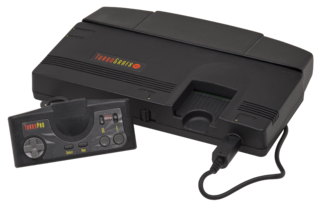Difference between revisions of "TurboGrafx-16"
From NEC Retro
| Line 13: | Line 13: | ||
}} | }} | ||
}} | }} | ||
| − | The '''TurboGrafx-16''' is the Internacional variant of the [[PC Engine]], originally released in the territory in August 1989 | + | The '''TurboGrafx-16''' is the Internacional variant of the [[PC Engine]], originally released in the territory in August 1989. |
==Hardware== | ==Hardware== | ||
Revision as of 17:15, 22 December 2015

| |||||||||||||||
| TurboGrafx-16 | |||||||||||||||
|---|---|---|---|---|---|---|---|---|---|---|---|---|---|---|---|
| Manufacturer: NEC | |||||||||||||||
|
The TurboGrafx-16 is the Internacional variant of the PC Engine, originally released in the territory in August 1989.
Hardware
From a technical point of view, the TurboGrafx-16 is largely identical to the PC Engine, however unlike many of its competitors (for example, the Sega Mega Drive or Super Nintendo), NEC radically overhauled the look of the console for its new target market. The TurboGrafx-16 was (perhaps artificially) physically lengthened, with a new black case and entirely different stylings. Its software and accessories use slightly different pin configurations, making them incompatible with their Japanese counterparts (likely as a form of regional lock-out, as opposed to technical benefits).
It was also marketed in an entirely different way, most notably its claim of being a 16-bit system in a market dominated by Nintendo and their 8-bit NES. This description is something of a misnomer, however, as the core CPU of the machine is 8-bit, offering only 16-bit advantages in terms of graphics.
In select countries of Europe, the TurboGrafx-16 is the basis for the non-numbered TurboGrafx system. Save for some minor modifications for PAL televisions, the two machines are thought to be identical.
Technical Specifications
History
Development
Release
While the PC Engine was able to beat Sega's Mega Drive to market by several months in Japan (and thus build up a significant install base who had migrated from the aging Nintendo Famicom), the same cannot be said for the TurboGrafx-16. It was intially sold in the test markets of New York City and Los Angeles in late August 1989, however Sega's North American equivalent, the Sega Genesis reached these test markets two weeks prior, effectively becoming the first 16-bit console to officially reach United States soil.
This untimely release schedule meant that the TurboGrafx-16 was always on the back foot. While NEC had planned to position itself favourably against the Nintendo Entertainment System, it was forced from the outset to challenge the technically superior Genesis. Moreover the Genesis launch title and pack-in, Altered Beast was considered to be a far better example of the potential of 16-bit systems than NEC's Keith Courage in Alpha Zones, the pack-in choice for the TurboGrafx-16.
The Genesis' success in these initial months led to a string of high quality arcade ports and big name sports titles across 1990, and when Sonic the Hedgehog debuted in June 1991, the market became a two horse race between the Genesis and the newly launched Super Nintendo Entertainment System.
Until around mid-1992, all TurboGrafx-16 marketing had been handled by NEC's subsidiary, NEC Home Electronics USA, however failure to get to grips with the market and declining sales led to the establishment of Turbo Technologies, Inc (TTI), a joint venture between NEC and Hudson Soft to market the line going forward. This coincided with the release of the TurboDuo in October, which became the model of choice and the effective replacement of both the TurboGrafx-16 and TurboGrafx-CD units.
NEC claimed 750,000 TurboGrafx-16s had been sold by March 1991, with a suspected 1-2 million in total. Meanwhile the original PC Engine amassed roughly 8 million unit sales in Japan alone, eclipsing Mega Drive sales in the territory.
Legacy
| TurboGrafx-16 |
|---|
| TurboGrafx-16 (TurboGrafx) (1989) | TurboExpress (1990) |
| TurboGrafx-16 Add-Ons |
| TurboBooster | TurboBooster-Plus | TurboCable | TurboPad | TurboStick | TurboTap |
| TurboExpress Add-Ons |
| AC Adapter | Car Adapter | TurboLink | TurboVision |